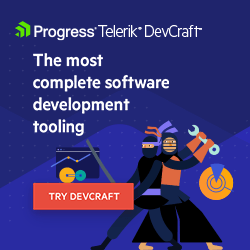Day-Zero Support for .NET 10 Across Progress Telerik

The .NET 10 official release marks another milestone in Microsoft’s journey toward boosting developer experience and future-proofing the .NET platform. With this release, Progress is shipping Telerik products with day-zero support for .NET 10.
Telerik UI libraries now fully support .NET 10 across AI-first, web, desktop and cross-platform applications, including reporting, document processing, mocking tools, Visual Studio and Visual Studio Code extensions.
By aligning with Microsoft’s latest release: ASP.NET Core 10, Blazor, .NET MAUI and Aspire 13, we enable developers to immediately benefit from improved performance, security and experience. Together, these updates deliver a cohesive ecosystem that helps teams move faster with fewer surprises and smarter tools for AI-assisted development.
Here’s the full list of Telerik UI libraries and tools that now offer day-zero support for .NET 10:
- Telerik UI for Blazor
- Telerik UI for ASP.NET Core
- Telerik UI for .NET MAUI
- Telerik UI for WinForms
- Telerik UI for WPF
- Telerik Reporting
- Telerik JustMock
- Telerik Document Processing Libraries
ASP.NET Core 10: Smarter APIs and Observable Security
ASP.NET Core 10 continues to refine minimal APIs for real-world productivity while introducing measurable security and a smoother developer experience.
Highlights
- Simplified validation: You can decorate your models with attributes like
[Required],[EmailAddress],[MaxLength], etc., and the framework will automatically validate them when bound to endpoints. Invalid requests return a standardized 400 Bad Request withProblemDetails. - Standardized error contracts: Validation results integrate with
IProblemDetailsService, producing consistent, standards-compliant responses. - Observable security: Authentication and identity flows emit metrics so you can track login attempts, session behaviors and user management activity.
- API-friendly auth: Cookie redirects are automatically disabled for known API endpoints, allowing for clean 401/403 responses instead of unexpected redirects.
The result? Less ceremony, better observability and security you can measure. Combined with Telerik UI for ASP.NET Core and Telerik UI for Blazor, you can immediately leverage these APIs in modern full-stack web applications.
Blazor in .NET 10: Enterprise-Ready UX and Security
Blazor reaches a new level of enterprise readiness with production-grade security, predictable interop and smarter UI primitives.
Blazor Web App, Security and Identity Guidance
- Updated Blazor Web App enterprise level security authentication samples for OpenID Connect, Microsoft Entra ID and Windows Authentication.
- Built-in patterns for secure API calls and encrypted, distributed token caching.
- Azure Key Vault integration helps protect secrets from landing in source control.
UI and State Management
- QuickGrid RowClass lets you apply conditional styling directly in markup.
- New ReconnectModal and NotFoundPage components make long-lived sessions and routing errors clear and maintainable. These additions enable UI customization, so your brand and theme are fully represented end to end.
- Blazor in .NET 10 introduces a declarative attribute to persist component state. Declarative circuit persistence in Blazor lets you declare which component state should survive disconnections.
Interop and Performance
- Direct JavaScript object creation and property access improve hybrid workflows.
- The new synchronous JavaScript interop allows .NET code running in the browser to call JavaScript functions and immediately get a return value without awaiting an asynchronous task. This reduces overhead for small, fast JS calls (like DOM queries or math operations), making apps more responsive.
- Static assets are now delivered with automatic compression and preload support, which reduces startup latency and improves time-to-interactive for Blazor apps.
These updates make Blazor more predictable, secure and performant. With Blazor you can ship interactive, cloud-ready applications faster, with the same .NET skills your team already uses. Add the newly updated Telerik UI for Blazor components to perfectly complement the .NET 10 enhancements.
.NET MAUI 10: Faster XAML, Safer Layouts, Better Insights
The .NET 10 MAUI release doubles down on productivity and platform alignment. With faster builds, safer layouts and richer diagnostics, developers can now iterate quickly while maintaining cross-platform consistency.
Developer Experience
- XAML source generation for .NET MAUI reduces build times by compiling XAML into strongly typed code at design time, eliminating runtime parsing overhead and improving developer productivity.
- Implicit/global XML namespaces cut repetitive markup and improve readability. Developers can opt-in to implicit namespaces by enabling
MauiAllowImplicitXmlnsDeclarationin the project file. This automatically injects the default MAUI and x: namespaces, meaning you can even omitxmlnsfrom your XAML files.
Platform Features
- SafeAreaEdges (Android) keeps inputs visible when keyboards appear.
- Microphone permissions (Windows) enable secure audio scenarios on desktop.
- WebView request interception supports auth headers, tracker blocking or routing.
- MediaPicker adds multi-select and compression options for smaller payloads.
Diagnostics and Performance
- New layout performance metrics highlight measure/arrange bottlenecks.
- Async animation APIs improve responsiveness and prevent UI thread stalls.
These improvements translate directly into faster iteration and more responsive mobile and desktop apps, without sacrificing reliability. Include the updated Telerik UI for .NET MAUI bits and hit the ground running.
Visual Studio 2026: Built for the Future of .NET Development
Visual Studio 2026 complements .NET 10 with a faster, more intelligent and future-ready development environment. With AI built directly into everyday workflows such as adaptive paste, AI-assisted debugging and project-aware Copilot integration, developers can write, test and optimize code faster and with fewer errors.
The new AI Profiler goes a step further, proactively identifying performance bottlenecks and suggesting fixes, so your applications run smoother and more efficiently.
With native support for .NET 10 and C# 14, developers get immediate access to the latest language and runtime improvements. Visual Studio 2026 also brings enhanced stability, performance and Arm64 optimizations, delivering a seamless experience on modern hardware.
Telerik Visual Studio extensions, including Telerik UI for ASP.NETAJAX, ASP.NET Core, ASP.NETMVC, Blazor, .NET MAUI, WinForms, WPF, WinUI, Telerik JustMock and Telerik Reporting, are fully compatible with Visual Studio 2026 from day one.
Embracing the AI & .NET Developer Ecosystem with Telerik MCP Tools
Over the past several months, we have enabled AI-assisted development across our web developer ecosystem through Node.js-based MCP (Model Context Protocol) servers. Developers can quickly start a Telerik MCP server using:
npx @progress/telerik-blazor-mcp
This tooling uses the developer’s seat license to securely connect to the Telerik search index and provide an AI-optimized gateway to component docs, demos and patterns, allowing AI code generation to use the full breadth of Telerik UI capabilities.
While the workflow has been very accessible for teams already working in JavaScript and Node.js environments, it didn’t embrace the .NET ecosystem. Many .NET developers primarily operate in native .NET tools and don’t always have Node.js installed. To address this gap in developer experience, we have pivoted our MCP tools to use NuGet.
With .NET 10: One-Line MCP Tooling via NuGet
The introduction of the new dnx launcher in .NET 10 enables command-line tooling to be distributed and executed directly via NuGet packages—no Node.js required. Once the .NET 10 SDK is installed and dnx is on your PATH, packages can be executed directly using:
dnx <package-name>
This unlocks the same seamless MCP server experience for .NET developers.
We now ship MCP-enabled packages on NuGet.org, allowing you to add Telerik product MCP servers directly to your mcp.json:
{"servers": {"telerik-wpf": {"command": "dnx","args": ["Telerik.WPF.MCP", "--yes"]}} }
This makes AI-assisted component guidance and code generation tools first-class features in desktop and cross-platform .NET environments. Developers can now work with the tooling provided by their native environment, just as web developers have already become accustomed to.
Available Today for Multiple Telerik Product Lines
You can now use .NET MCP servers for:
| Product | Documentation |
|---|---|
| Telerik UI for WinForms | WinForms documentation |
| Telerik UI for WPF | WPF documentation |
| Telerik UI for .NET MAUI | .NET MAUI documentation |
| Telerik Document Processing Libraries | DPL documentation |
| Telerik Reporting | Reporting documentation |
What This Means for Your Development Workflow
- No Node.js requirement for desktop and enterprise-centric .NET teams
- Direct NuGet-based installation and command execution
- AI guidance and sample generation aligned with your licensed product version
- Unified MCP experience across web, desktop and cross-platform UI stacks
This release closes the tooling gap between web-first and .NET-first development environments and significantly improves accessibility of the AI Assistant for enterprise .NET teams.
Aspire 13 + .NET 10: Streamlined Workflows and AI Observability
Aspire 13 aligns with .NET 10’s mission of frictionless developer experience, introducing smarter CLI tooling, single-file AppHosts and deep observability for AI-driven apps.
Preview Bits
- SingleFile AppHost (Preview): Instead of multiple projects, you can declare your distributed app in one file, reducing boilerplate and making prototypes faster
CLI Enhancements
- New Aspire update command to automatically detect and upgrade outdated packages.
- Channel aware package selection (stable, daily, custom builds).
- Remote port forwarding and improved aspire exec for scripting tasks.
AI Observability
- Generative AI Visualizer in the dashboard to inspect prompts/responses when integrating LLMs.
- Expanded integrations for GitHub Models, Azure AI Foundry and OpenAI, with typed client libraries for easier connections.
- LLM specific metrics: token usage, latency, temperature, stop sequences and function call traces.
Aspire 13 streamlines workflows so developers spend less time wiring services and configs. Aspire’s single‑file AppHost, CLI automation and unified templates reduce friction in setup, upgrades and deployment. In addition, as AI becomes core to apps, Aspire now treats LLMs as first‑class resources. Developers can visualize prompts, monitor token usage and trace AI calls alongside traditional logs and metrics.
Together, Aspire 13 and .NET 10 position .NET as a cloud‑native + AI‑native platform, where distributed systems and intelligent agents can be modeled, debugged and deployed with consistency and transparency.
Conclusion
The .NET 10 release, supported day-zero across Telerik products, represents a significant step forward in developer productivity, security and AI integration. From ASP.NET Core 10’s smarter APIs and enhanced security observability, through Blazor’s enterprise-ready UX improvements, to .NET MAUI’s faster builds and safer layouts, each update empowers developers to build modern, performant and secure applications. Aspire 13’s streamlined workflows and AI observability further position .NET as a cloud-native and AI-native platform.
Finally, the evolution of Telerik MCP tooling to a NuGet-based, Node.js-free experience unifies AI-assisted development across web, desktop and cross-platform environments. Together, these advancements reinforce Progress’ commitment to delivering seamless, future-ready tools coordinated with Microsoft that help developers innovate with confidence and speed.

Ed Charbeneau
Ed

